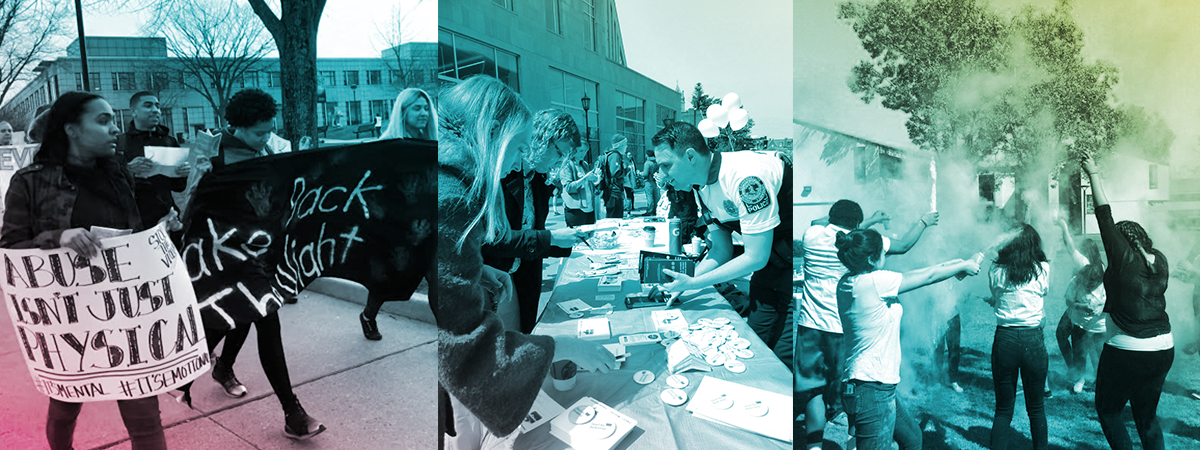
During April 2018, campuses throughout the country hosted a variety of events to recognize Sexual Assault Awareness Month. We checked in with the hard-working planners of these events to learn more about the goals of their events, their planning process, and lessons learned for next time. The organizers shared how worthwhile the hours of planning were in helping to create a meaningful impact in their campus community. Organizers also shared invaluable advice for those who are planning events in 2019.
Nathan with Tarleton Student Counseling Services in Texas
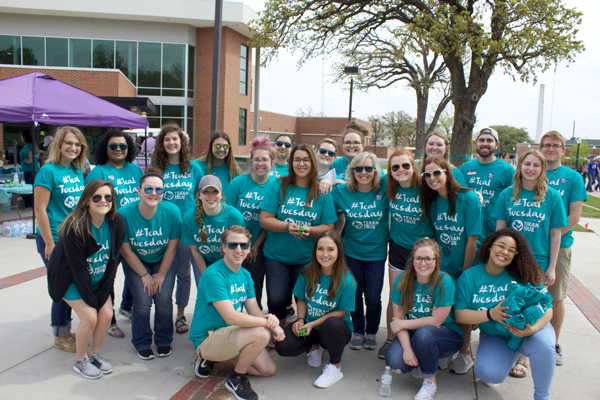
Tell us about the event:
On the first Tuesday of April, we held a Teal Tuesday Kickoff event for SAAM on campus. We drew people in with free food, coffee, and t-shirts in the most high-traffic area of campus. We also provided information about how to get involved in spreading awareness and preventing sexual assault, and about the resources available for survivors. Campus and community advocates were present at the event to respond to questions from participants. The university radio station provided music to accompany the event. The goals of the kickoff event were to educate the campus about SAAM, how everyone can be part of raising awareness and preventing sexual assault, and provide information about campus and community resources available to survivors.
What was the planning process like?
We began planning the event in February. Responsibilities were divided among our staff, with one person coordinating the event as a whole. We partnered with a class of sixteen students who also volunteered at the event. We also partnered with a student organization who had several volunteers work the event.
How did you promote the event?
The event was advertised in partnership with the university’s Student Affairs Marketing Department. Tarleton Student Counseling Services and Student Affairs Marketing Department worked together to promote the kickoff event using social media, the university calendar, and the university’s daily email digest for faculty, staff, and students. Tarleton Student Counseling Services social media accounts were also used to promote the event. It was further promoted by connecting with influential students, staff, and faculty.
What were some of the successes?
One success of the event was the many partnerships which came together to make the event bigger and better than Tarleton Student Counseling Services could have ever done alone. We collaborated with an undergraduate event-planning class to assist in planning and staffing the event. We also collaborated with the community sexual assault prevention and response agency, to provide information about community resources and volunteer opportunities. The Student Affairs Marketing department, as well as the university’s radio station, were utilized to promote the event.
We reached about 800 students, which is about 8% of our university, with information about how they could be involved in spreading awareness and preventing sexual assault. In turn, these students were engaged in continuing to spread awareness beyond the event itself.
How could you make the event even better next year?
We greatly underestimated the university’s response to the event. At the halfway point, we were completely out of flyers and brochures, t-shirts, and snacks. Half of the scheduled time period for the event remained and we had no way of continuing the event. One area of improvement for next year, is having more of an action piece within the event itself. However, this must be done while balancing engaging students with their busy schedules. Another area of improvement is building in nexus to keep the energy and engagement of the event going through the month.
What advice do you have for someone planning a SAAM event for the first time?
Tie your event in with the culture of your campus or community. Our campus has a tradition called Purple Thursday where everyone wears the university’s color of purple on Thursday. Therefore, having Teal Tuesdays in April to raise awareness of sexual assault fit in with the campus’s existing traditions and culture.
Do not be afraid to start small. The partnerships which made this event possible were made over the course of several years and many conversations. Likewise, relationships with influential members of the campus to promote the event took time to build.
Striking a balance of talking about a difficult topic in a way that honors the reality of sexual violence while not being so difficult or divisive to drive people away can be challenging. During SAAM, we try to focus on how to be part of the solution. We operate from an assumption that people don’t wish to see others harmed and that they will choose to be part of the solution if given the opportunity. That assumption underlies the way we approach and talk about sexual assault. So when we are doing outreach, we do it in a way that is upbeat and uplifting, which helps draw interest.
Giveaways or free food can also help with drawing participants in, especially on a college campus. Giveaways can also be something which helps to continue to spread awareness. For example, we gave out teal awareness t-shirts. These t-shirts continue to spread awareness whenever someone wears one. Student involvement is crucial, too. Students respond better when their peers are involved in outreach efforts than when it’s just staff members, so if there are even a few members of a student group or class who can help with an event, that is likely to increase your attendance/involvement from the greater student body.
Theresa with William Paterson University in New Jersey
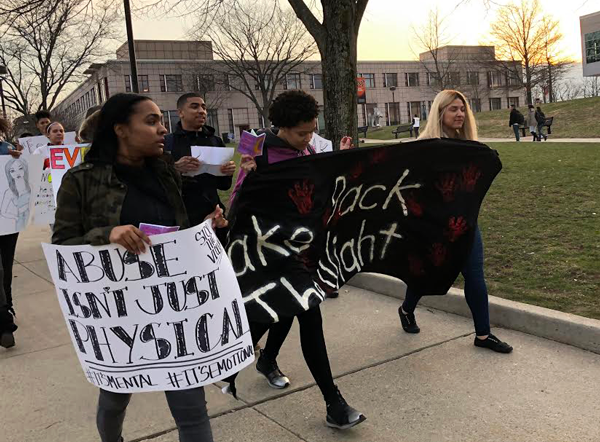
Tell us about the event:
We held a Take Back the Night rally, speak out, and march. The goal of the event was to provide survivors and supporters an opportunity to speak out against sexual violence.
What was the planning process like?
We sent out an email seven weeks prior to the event to recruit students and staff for a planning committee. We ended up with a team of ten to twelve students, staff, and interns.
How did you promote the event?
We used flyers, social media, email blasts, and emails to both professors and students.
What were some of the successes?
This was the largest crowed we've had since I've been at WPU (approx. 80 people), we held the Speak Out during the public rally which we haven't done before. This allowed survivors and supporters the chance to say what they wanted. We also had students sing two songs (Praying and Beautiful).
How could you make the event even better next year?
Continue to recruit for volunteers and to build our network of students supporting this event. We need more help from students to publicize the event.
What advice do you have for someone planning a SAAM event for the first time?
You will end up doing a lot of the work yourself. Have a least one or two trustworthy colleagues to help and be a sounding-board. It's also important to get as much input from students as possible.
Cecilia at V.O.I.C.E. (Violence Outreach Informing our Community with Education) at California State University, San Bernardino.
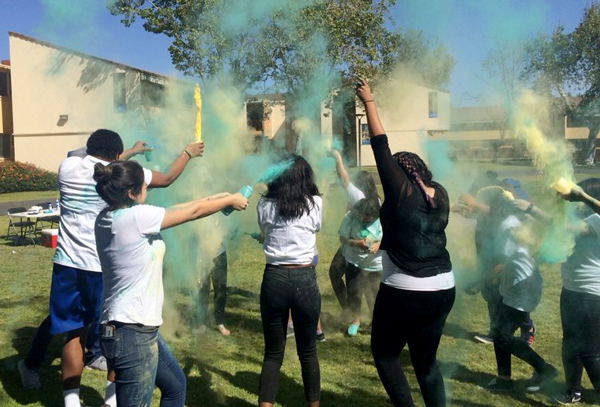
Tell us about the event:
The basis of the event was a mini carnival/ festival of color for SAAM. We had multiple carnival games and resources for survivors from the California State University, San Bernardino (CSUSB) campus advocate, and other local sexual assault services. Throughout the event, we would chant thing such as "When survivors are under attack, what do we do? Stand up, fight back!" two to three times and then release a teal-colored powder.
What was the planning process like?
My planning took a lot of organizing to keep track of meetings and emails with other organizations. I started brainstorming at the end of 2017 and started organizing around the beginning of 2018. I utilized our campus Department of Housing (DHRE) to help with finding locations. I also reached out to sororities and fraternities who helped with drinks, snacks, and volunteering.
How did you promote the event?
We advertised with flyers around campus and through social media.
What were some of the successes?
I think the biggest success was bringing resources and awareness surrounding sexual violence.
How could you make the event even better next year?
One thing that could have been improved would be having an assistant helping me organize along the way. I would also want to plan a little sooner. Although 4-5 months is a long time, I think it would be better just to catch all the little problems that could arise as the date gets closer while also giving us wiggle room for any possible mistakes.
What advice do you have for someone planning a SAAM event for the first time?
DELEGATE. Having just one partner will help lower the stress of planning the event. Also, remember why you are doing the program. If you're planning a SAAM event, you're already doing something amazing for your community and for survivors around the world.
Morgan with Virginia Commonwealth University (VCU) Police Department
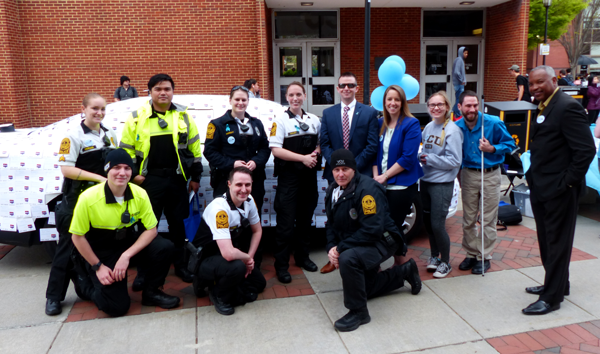
Tell us about the event:
Our event was called Cover the Cruiser. Students and community members were encouraged to cover the university police cruiser with pledge cards that vow they will “start by believing” survivors when they disclose that they have been assaulted.
What was the planning process like?
The planning process took about two months to come up with the idea, set a date, reserve an event space on campus, acquire the items for the event (pledge cards, swag, supplies, etc.). We staffed our event with our Victim Witness Officers, Investigators, VCU Police Volunteers, and community policing officers. We also gathered resources from our on-campus partners and counseling center as well as our local Assistant Commonwealth Attorney, who attended.
How did you promote the event?
We promoted through our campus newsletter, through social media, and word-of-mouth with other partners who promote SAAM events.
What were some of the successes?
Our goal was to obtain 1,000 pledges and to cover a police cruiser with all of the signed pledge cards. We surpassed our goal and obtained 1,021 signatures and pledges which completely covered the cruiser.
How could you make the event even better next year?
Areas for improvement would be more advanced planning. Our swag arrived about 20 hours before our event and caused a lot of unnecessary stress, which took up a lot of time in the end.
What advice do you have for someone planning a SAAM event for the first time?
Start planning and order swag early, and don't underestimate your ability to reach your goals. SAAM is so important, and it's amazing how many people will be influenced by your event. We had so many people approach us with their stories, good and bad, but they all were so appreciative of us spreading support for sexual assault survivors.
Tracy with Indiana University East
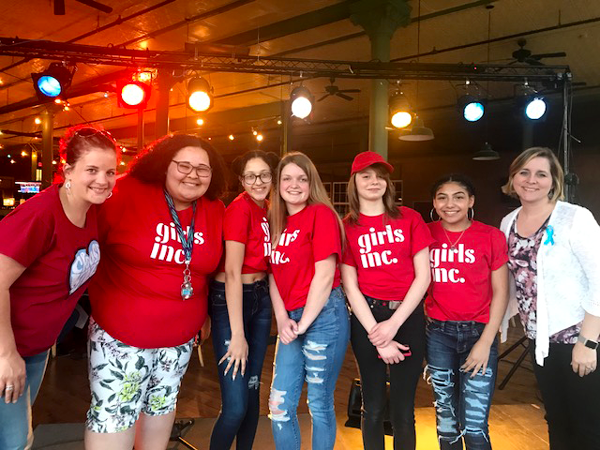
Tell us about your event
We hosted a poetry slam that allowed speakers to use the power of spoken word, readings, song, or personal testimony to break the silence surrounding sexual assault. The goal of the event was to allow survivors to embrace their voice and begin the healing process as well as educate and bring awareness surrounding sexual violence.
What was the planning process like?
In conjunction with the Title IX Steering Committee at our university, we began planning in January. Due to the immense turnout last year, the committee decided to host this year’s poetry slam at a larger venue. We collaborated with a local venue and the university's external affairs department who created marketing materials and helped with advertising on campus and through social media.
How did you promote the event?
Our campus external affairs department assisted with creating marketing materials. These materials were advertised on campus through Wolf Vision, What's Up, flyers, window art, and table tents. The event was also promoted via campus email and through various University social media outlets. We were also fortunate to have strong local connections who assisted with sharing the flyer around town and through their personal social media accounts.
What were some of the successes?
Since the event was open to the community, we had a group of young women from the local high school share their personal experiences and “embrace their voice.”
How could you make the event even better next year?
Something we would like to improve is the attendance of IU East students at the poetry slam. Next year we plan to seek out more students who are passionate about sexual violence prevention and are willing to participate in the event and planning.
What advice do you have for someone who is planning a SAAM event for the first time?
Understand the needs of your students and center programming around those needs, develop a group of key stakeholders on campus to secure buy-in and support, begin organizing events at least four months in advance, delegate events to sub-committees, and seek a student voice.
Allison with Augusta University in Georgia
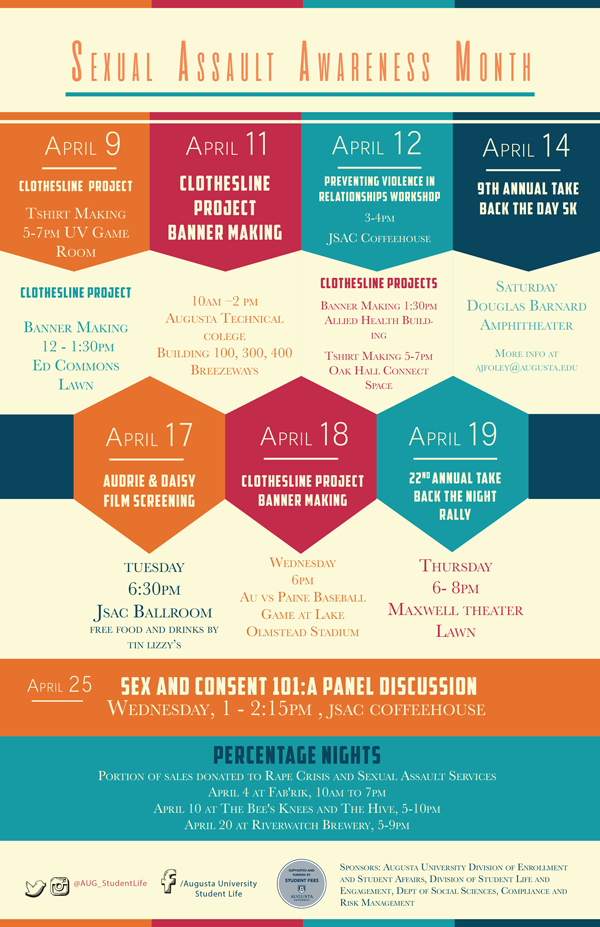
Tell us about your event
We had a month-long SAAM series including Take Back the Night; a screening and discussion of Audrie & Daisy; a 5K we called Take Back the Day which benefited our local rape crisis center; a panel discussion on consent; a workshop on preventing violence in relationships; and four events related to the Clothesline Project.
Our goal was to raise awareness of the resources for survivors in our community, rally people to be good allies to survivors, and raise money for our local rape crisis center.
What was the planning process like?
We start behind-the-scenes planning (reserving space on campus) in fall but begin meeting in early January. We meet every other week in January and February, weekly in March, and as needed in April. Our resources include university funds, university employees to set up for most events, donations to our rape crisis center as sponsorships for the 5K race, rape crisis center volunteers, and about 100 other volunteers, mostly to keep the roads marked off for the 5K.
How did you promote the event?
We advertised with flyers made by the university, two promo ads made by a local production and advertising company, special segments on local news, Facebook, Instagram, university-based emails, and tabling around campus and at fundraisers held for rape crisis centers.
What were some of the successes?
We had our biggest turnout ever for our 5K and for Take Back the Night. This really was our biggest year ever in terms of the number of events we had and the number of businesses sponsoring the 5K or hosting a percentage night fundraiser.
How could you make the event even better next year?
Unfortunately, attendance at our film screening was the lowest it has ever been (film screenings have been declining in popularity for a while on our campus), and we need to check, recheck, and triple check that all university workers who are setting things up for us know exactly what their job is.
What advice do you have for someone planning a SAAM event for the first time?
Start small and start early. Expect some ideas to fall through because there is not enough time for them, but that’s okay!
Jessica with Grand Valley State University in Michigan

Tell us about your event
Our organization planned a week of events, beginning with a Keynote speaker (Alex Jenny) on Monday, April 2nd, a roundtable discussion on rape culture, a tea party/panel on consent and healthy relationships, campus denim day, and a film screening and discussion of I Am Evidence. Our goal was to spread awareness on sexual assault, bystander intervention, and consent.
What was your planning process like?
We started planning in December. Most of the planning was done by myself with the help of two other officers. We utilized community resources such as the YWCA, Planned Parenthood Advocates of Michigan, and campus resources such as Student Senate, Division of Inclusion and Equity, and the Women, Gender, and Sexuality Studies Department.
How did you promote the event?
We promoted heavily on social media, flyers, posters, and pluggers around campus.
What were some of the successes?
We had a much better attendance than events in previous years. We were also able to get enough funding to have the keynote, Alex Jenny (Alex Ngo), visit our campus, which was quite the process.
How could you make the event even better next year?
In the future, the organization should start planning much further in advance. Funding should be handled way earlier than we did this year to avoid any last minute issues. In the future, I think it would have been helpful to do more tabling.
What advice do you have for someone planning a SAAM event for the first time?
Get started early and stay focused. Check and re-check room reservations, food orders, speakers, and all of the other details to avoid problems during the event.
Olivia with Oklahoma State University
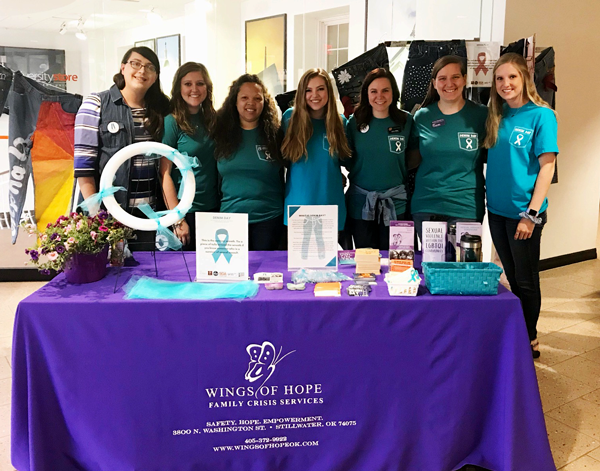
Tell us about your event
Community members, student organizations, and faculty and staff had the opportunity to decorate jeans to be displayed to show their support for survivors sexual assault. In the evening we moved the display to a ballroom and had a symposium to honor survivors that included music, consent education, a guest speaker, food, and giveaways. Our goals were to educate the student population about consent and bystander intervention, and show survivors that their college community and other community members support them and do not stand for sexual violence.
What was your planning process like?
We began meeting with team members from our local crisis center, Wings of Hope, in January. We met monthly until March when we began meeting bi-weekly. We started planning marketing and plans for the event early on and as time moved forward we contacted different stakeholders and partners for their involvement. We did have a lot of volunteers from student organizations on campus. We also had several student organizations donate money for the event.
How did you promote the event?
We used social media, posters, word of mouth, Facebook event, and emails to faculty and staff.
What were some of the successes?
We had over 100 people attend the symposium, people stayed later than we intended, and many people felt motivated by our guest speaker's message. Also, students are really drawn to peer entertainment (we had a student as the guest speakers and musical entertainment).
How could you make the event even better next year?
We need to get more student organizations to create jeans for the daytime display, and we would be more successful if the weather would cooperate and we could take the display outside. Although we started planning early on we may need to work on marketing and advertisement even earlier in the process.
What advice do you have for someone planning a SAAM event for the first time?
Work with other partners rather than doing everything on your own.
Bridget with University of Alaska Anchorage

Tell us about your event
#SeawolvesSpeakUp was a photo and awareness campaign. It allowed for students, faculty, and staff to share how or why they decide to speak up.
What were the goals of your event?
Our goal was to show our entire Seawolf community that it takes all of us to speak up in order to end rape culture and to create a culture of support and consent.
What was your planning process like?
I worked with the folks in our advancement office and a local photographer.
How did you promote the event?
We used posters and social media.
What were some of the successes?
We had quite a few students show up for the event, and all seemed to really enjoy themselves.
How could you make the event even better next year?
Due to some last-minute scheduling conflicts, we had to change the date of our event. I think if we would have been able to keep the original date, we would have had more folks show up.
What advice do you have for someone planning a SAAM event for the first time?
Delegate, and don't focus on the number of attendees — focus on the quality of your event.
Marianne with Holy Family University in Pennsylvania
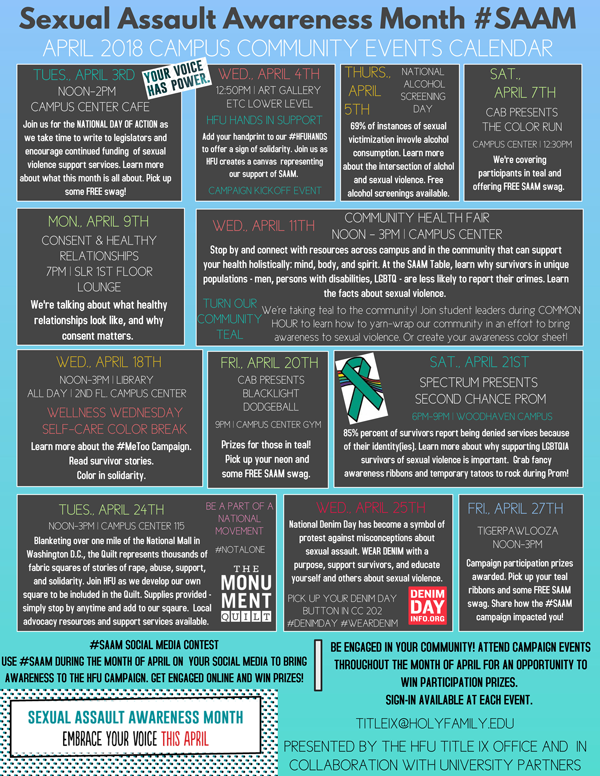
Tell us about your event
We held a month-long SAAM event. The goal was to provide exposure to students on the topics of sexual violence, and expand opportunities for students to learn about basic concepts and constructs related to sexual violence.
What was your planning process like?
We began the schedule draft in February. We relied on many of the SAAM planning toolkit resource documents. We put together a team of program planners from a number of areas on campus — Student Engagement, Freshman Year Experience, Counseling Services, Health Services, Residence Life, Campus Activities Board, and the Student Government Association — to help design our program calendar and discuss collaborative opportunities.
How did you promote the event?
We used social media, posters, email.
What were some of the successes?
We ordered a ton of stickers, tattoos, palm cards, etc. from NSVRC to help have items to take away from our events. They were a hit! We also tried to have unique giveaways at our collaborative events so that students saw new things each week.
How could you make the event even better next year?
We will have a climate survey completed prior to next SAAM — so we are planning to really make some data-driven decisions in our program planning. We also want to incorporate more student representation into our planning process.
What advice do you have for someone planning a SAAM event for the first time?
Use your colleagues for support! This was my first SAAM at this institution, so I relied heavily on those who have been here before and on those doing programming on our campus to help support our programs and meet the needs of students. Collaborate. We are a small school with limited funds. We found creative ways to support each other.
Max with Elon University in North Carolina
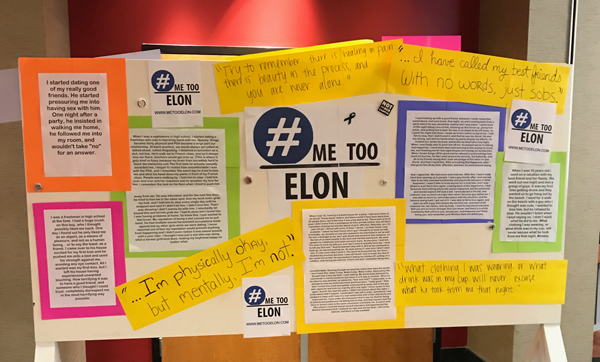
Tell us about your event
Our event, which we called MeToo Elon, has collected anonymous stories from students, alumni, and staff, of all identities for the purpose of bringing awareness to gender-based violence in Elon's community. Through a website, social media platform, and a large well designed to display in our university's student center, these stories have been shared with the Elon community in an effort to show community members that sexual harassment, assault, and relationship abuse exists within our small community.
What was your planning process like?
We put together a core executive team of four students and two faculty advisors. Our planning was a two- to three-month process, and we utilized the resources of our faculty advisors who worked in the GLC and SPARKS. Both organizations focus on advanced educational programs, support, and advocacy for students, employees, and alumni to succeed at Elon and beyond.
How did you promote the event?
We used Facebook and Instagram advertising and an email campaign.
What were some of the successes?
Two successes were being featured on our university's morning show and a strong showing at our take back the night event where our physical display received much attention.
How could you make the event even better next year?
More traction. We have 16 stories and received over 300 website views as well as have 30 Facebook likes. I would like to increase our Facebook presence.
What advice do you have for someone planning a SAAM event for the first time?
Work with your school and the resources they are able to provide. In doing so decision-making becomes more successful because a sensitive topic has specific ways certain things must be displayed in order to not offend survivors of sexual assault. For example, in our marketing tactics, we were going to put flyers in the bathrooms. When we voted on this decision to place flyers in the bathroom we came to the conclusion that the bathroom was too personal of a space to display our MeToo posters.
Explore even more SAAM events that took place in communities.
